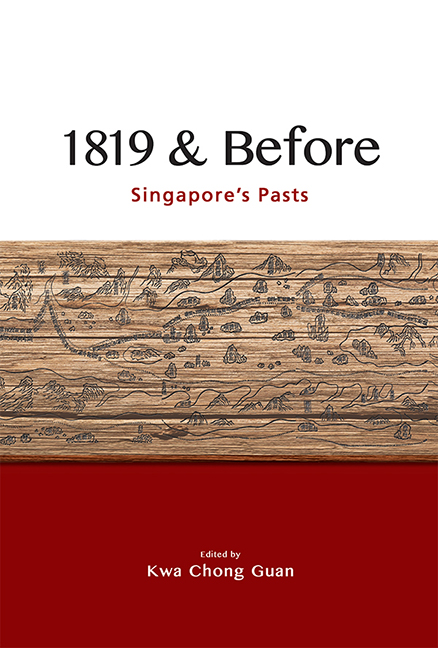Book contents
- Frontmatter
- Contents
- Foreword
- Acknowledgments
- Contributors
- 1 Introduction: Approaches to Singapore’s Past before 1819
- 2 Issues and Approaches to Studying Singapore before 1819
- 3 Regional Influences, International Geopolitics and Environmental Factors in the Rise and Demise of Temasek
- 4 The Mysterious Malay Jong and Other Temasek Shipping
- 5 The Orang Laut and the Negara Selat (Realm of the Straits)
- 6 Avoidance of Shipwreck in the Malay Annals: A Trope in Buddhist Narratives of Maritime Crossings
- 7 The Inception of Lion City
- 8 A Note on Amoghapāśa-Lokeśvara in Singapura
- 9 Portuguese and Dutch Records for Singapore before 1819: An Overview
- 10 Zheng He’s Navigation Methods and His Visit to Longyamen, Singapore
- Bibliography
- Index
1 - Introduction: Approaches to Singapore’s Past before 1819
Published online by Cambridge University Press: 09 October 2021
- Frontmatter
- Contents
- Foreword
- Acknowledgments
- Contributors
- 1 Introduction: Approaches to Singapore’s Past before 1819
- 2 Issues and Approaches to Studying Singapore before 1819
- 3 Regional Influences, International Geopolitics and Environmental Factors in the Rise and Demise of Temasek
- 4 The Mysterious Malay Jong and Other Temasek Shipping
- 5 The Orang Laut and the Negara Selat (Realm of the Straits)
- 6 Avoidance of Shipwreck in the Malay Annals: A Trope in Buddhist Narratives of Maritime Crossings
- 7 The Inception of Lion City
- 8 A Note on Amoghapāśa-Lokeśvara in Singapura
- 9 Portuguese and Dutch Records for Singapore before 1819: An Overview
- 10 Zheng He’s Navigation Methods and His Visit to Longyamen, Singapore
- Bibliography
- Index
Summary
Singapore commemorated the bicentennial of Thomas Stamford Raffles's establishment of a British station on this island with a yearlong series of blockbuster exhibitions and accompanying international conferences and ground-up events involving community and volunteer efforts. In contrast to the centennial of Raffles's arrival in Singapore, which was a celebration of the achievements of the Crown Colony that had grown out of the British station Raffles established, the bicentennial was a commemoration inviting Singaporeans to reflect on the two hundred years of their island's past in the long cycles of the preceding five hundred years of time. For many, this invitation was a challenge, as the prevailing and dominant public narrative of Singapore was that it had only a two-hundred-year history.
This template of Singapore having a two-hundred-year history started by Raffles was laid down by Raffles himself. On 8 January 1819, Raffles reported to Governor-General Hastings that his inquiries at Pinang indicated that Singapore “has been deserted for Centuries and long before the Dutch power existed in these Seas”. British colonial officials from Dr John Crawfurd (1783–1868) have confirmed this. The template was consolidated by generations of historians, from Raffles Professor of History Kennedy G. Tregonning and his colleagues at the History Department of the old University of Singapore in the 1960s through to the 1990s.
Crawfurd, as the second Resident of Singapore after William Farquhar, would be in a position to authoritatively state that “for a period of about five centuries and a half, there is no record of Singapore having been occupied, and it was only the occasional resort of pirates. In that year [1811], it was taken possession of by the party from whom we [the British] first received it, an officer of the government of Johore called the Tumângung. This person told me himself that he came there with about 150 followers, a few months before the British expedition which afterwards captured Java passed the island, and this happened in the summer of 1811.”
L.A. Mills was the first to establish the founding of Singapore as the beginning of a history of British Malaya, 1824–67.
- Type
- Chapter
- Information
- 1819 & BeforeSingapore's Pasts, pp. 1 - 10Publisher: ISEAS–Yusof Ishak InstitutePrint publication year: 2021

